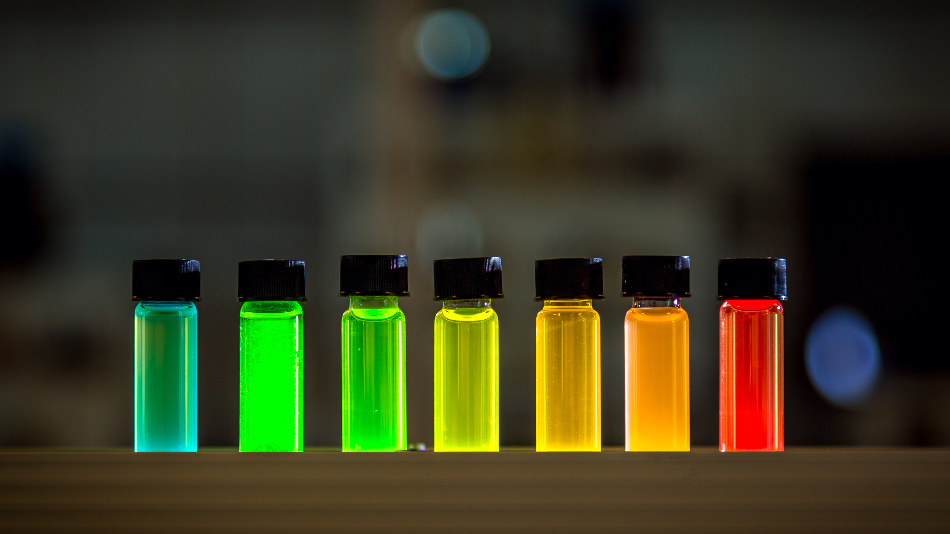Quantum dots have become a principal topic in nanotechnology, finding applications in varying fields, from renewable energy to medical imaging. First created back in the 1980s, the dots are made of tiny, man-made fluorescent semiconductor nanocrystals possessing unique properties. They transport electrons and have interesting optical properties, emitting fluorescent light of various colors stably, determined by the size of the quantum dot. For this reason, these impressive semiconductors have found use as fluorescent biological labels.

Image Credit: Tayfun Ruzgar/Shutterstock.com
What are quantum dots?
Materials constructed of elements from the periodic groups of II-VI, III-V or IV-VI are used to construct the man-made fluorescent semiconductor nanocrystals that make quantum dots. Containing between 200 and 1,000 atoms the dots measure just 2 to 10 nm in diameter. They demonstrate an array of impressive properties, from their emission spectra, slow excited-state decay rates, broad absorption, and broad absorption cross-sections. Their emission spectra can be tuned from ultraviolet to near-infrared by adjusting their size, surface chemistry, and chemical composition.
Special properties of quantum dots make them perfect as fluorescent biological labels
The electrical and optical properties of quantum dots differ depending on the material and shape of the artificial nanostructure. Giving scientists a great amount of control over their behavior, allowing them to be used in a multitude of applications and research areas.
The structure of the quantum dot also influences its properties. Scientists have developed ways to engineer the structure of quantum dots, giving them certain properties for use in specific applications, such as catalysis, electronics, photonics, information storage, imaging, medicine, sensing, and more.
A quantum dot’s unique properties are further added to by its atom-like energy state, resulting in its particle-size dependent on the wavelength of fluorescence. This property, in particular, has been exploited by the field of medical imaging.
Bio-analytics and bio-labeling have so far found the most use for quantum dots, due to their fluorescent properties. To establish their use in these fields, work was required to gain control over some important properties of the dots. For instance, at first, it was only possible to work with quantum dots within artificial environments, meaning that they could not be simply added into living samples such as blood. The past two decades have seen these problems overcome, allowing for quantum dots to be used as fluorescent biological labels, due to their tiny particle size and tunable energy levels.
Quantum dots in medicine
Biological imaging is an area that is constantly developing and improving, with techniques being evolved to allow scientists and doctors to see the human body in higher resolution with each progression. The ultimate resolution goal for biological imaging is seeing the body at the nanoscale as this would allow visualization of biological processes, which could potentially be viewed in real-time. This has been made possible with the advent of quantum dots as biological labels.
Quantum dots have been developed to bind to certain biological targets, creating images at the cellular and molecular level. Imaging with quantum dots has already had the impact of improving the treatment and diagnosis of illnesses such as cancer.
How they work is that once quantum dots have come into contact with the target, such as an analyte or antibody, the fluorescence properties of the quantum dots change, and their fluorescent emission signifies the presence or absence of the target substance.
The future will likely see these nano fluorescent semiconductors profoundly changing the face of medical diagnosis and treatment, however, first, they need to be developed further to make them safe to be injected directly into humans, as currently quantum dots contain heavy metals that are toxic to the human body.
Sources:
https://www.ncbi.nlm.nih.gov/pmc/articles/PMC3215221/
https://www.sciencedirect.com/topics/materials-science/quantum-dot
Disclaimer: The views expressed here are those of the author expressed in their private capacity and do not necessarily represent the views of AZoM.com Limited T/A AZoNetwork the owner and operator of this website. This disclaimer forms part of the Terms and conditions of use of this website.